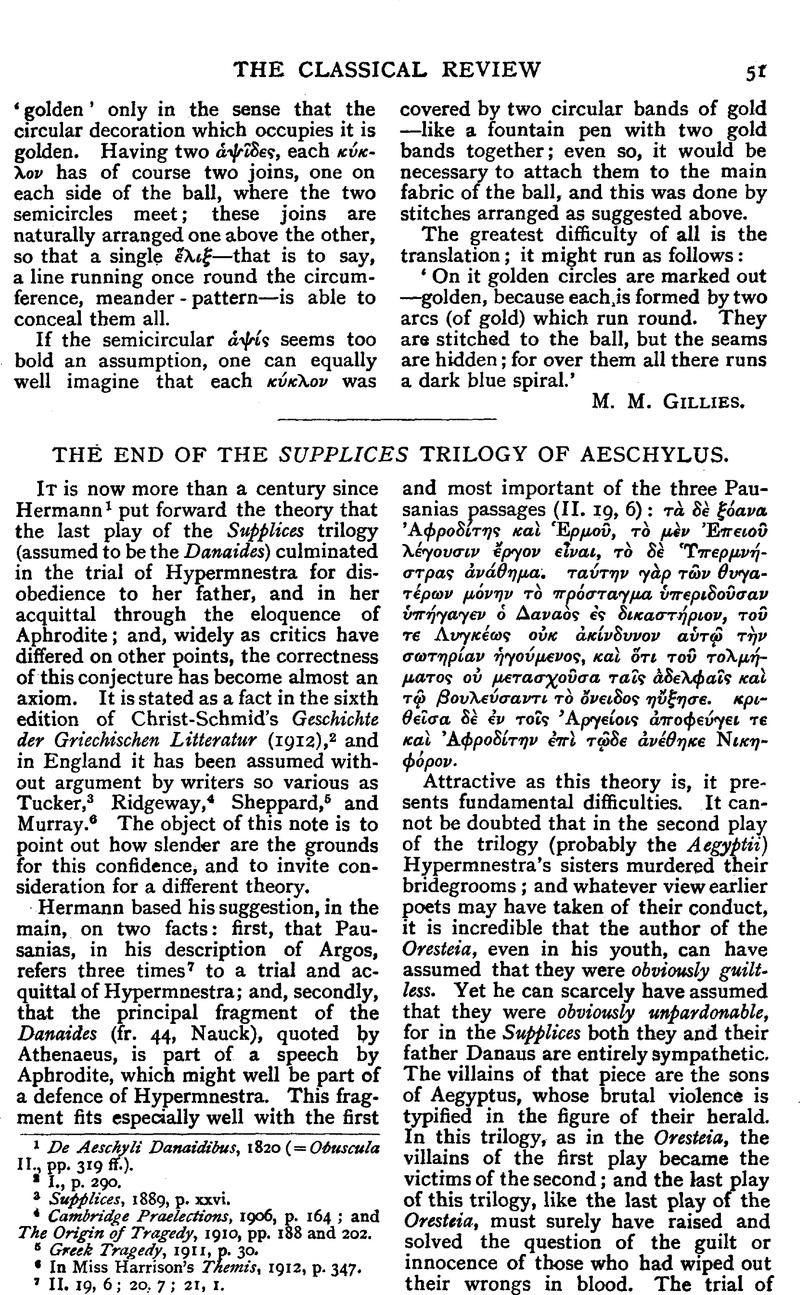Article contents
The End of the Supplices Trilogy of Aeschylus
Published online by Cambridge University Press: 27 October 2009
Abstract

- Type
- Review Article
- Information
- Copyright
- Copyright © The Classical Association 1924
References
page 51 note 1 De Aeschyli Danaidibus, 1820 (=Obuscula II., pp. 319 ff.).Google Scholar
page 51 note 2 I., p. 290.
page 51 note 3 Supplices, 1889, p. xxvi.
page 51 note 4 Cambridge Praelections, 1906, p. 164; and The Origin of Tragedy, 1910, pp. 188 and 202.
page 51 note 5 Greek Tragedy, 1911, p. 30.
page 51 note 6 In Miss Harrison's Themis, 1912, p. 347.
page 51 note 7 II. 19, 6; 20, 7; 21, 1.
page 52 note 1 Die Aesckyleische Trilogie, 1824, p. 405. He returned to this trilogy in Rh. Mus., 1846, pp. 481–510 (=Kleine Schriften IV., 1861, pp. 100–135).
page 52 note 2 I gather that Ahrens, G. L. in Zeitschr.f. d. Ant. Wiss., 1844, ‘BeiL zum Okt.,’ p. 4Google Scholar, anticipated my view by maintaining that the only trial in the last play was a trial of Danaus, but I have not seen this article. Haupt, C. G. (Supplices, 1829, p. 112)Google Scholar and Gruppe, O. (Ariadne, 1834, pp. 79 ff.Google Scholar) mentioned this half of Hermann's theory only to reject it. A. Tittler, in Zeitschr. f. d. Ant. Wiss., 1838, col. col. 1003, gives the now received view; and so do Nitzsch, G. W. in Die Sagenpoesie der Griechen, 1852, p. 563Google Scholar, and Wecklein, N. in Sitzb. d. philos.-philol. Kl. d. buyer. Ak. d. Wiss., 1893, II., pp. 393–450Google Scholar. I have not noticed any reference to the rejected theory later than Welcker's in Rh. M., 1846, and its 1861 reprint in his Kl. Schriften.
page 52 note 3 II. 1. 5.
page 52 note 3 II. 1.5.
page 53 note 1 After this article was written I discovered that this suggestion was made by Tittler, A. in Zeitschr. f. d. Ant. Wiss., 1838, col. 975Google Scholar, and that it was accepted by Welcker, in Rh. Mus., 1846, p. 503Google Scholar (=Kl. Schriften, pp. 120, 121). Neither critic attaches exactly the same significance to the suggestion as I do, and I have left my remarks as I originally wrote them. Since Welcker, the suggestion seems to have been ignored by students of Aeschylus and by students of Greek religion alike.
page 53 note 2 II. 171.
page 53 note 3 II. 156.
page 53 note 4 For Aeschylus' fondness for the mystical aspects of Demeter, cf. his oath in Aristoph. Ran. 886, and Aristotle, Eth. Nic. III. 2, p. IIIIa, with the comment of Eustratios (or ‘Anonymus’): 
page 53 note 5 E.g. Farnell, , Cults of the Greek States III., pp. 75 ff.Google Scholar
page 53 note 6 Hymn. Demet. 19; cf. Diod. Sic. V. 5 (quoted by Farnell, op. cit, p. 324, no. 64).
page 53 note 7 Paton and Hicks 386 (quoted ib., p. 326, no. 73).
- 3
- Cited by




